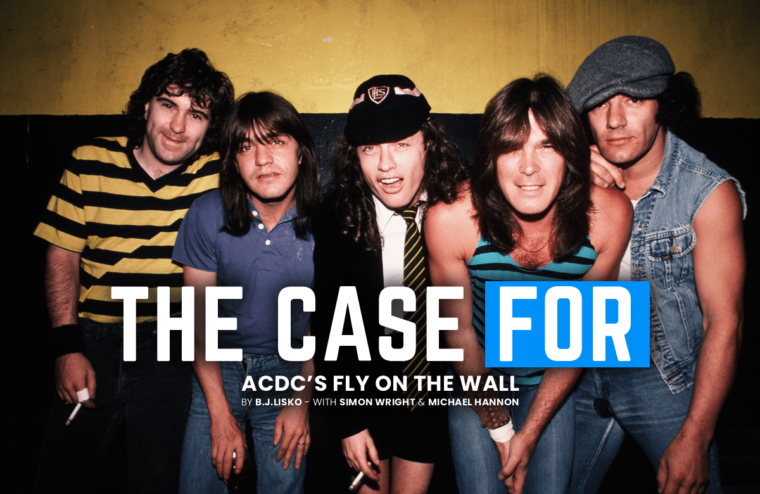Author’s note: The new Web Is Jericho column “The case for” is a re-examination of rock and metal albums that upon their release were maligned and/or critically and commercially dismissed but have come to be more appreciated over time. Articles will include insights from people directly involved as well as notable fans of said releases in addition to my own arguments for why critics and listeners should listen to these albums in a new light. Up first: AC/DC’s “Fly on the Wall,” featuring new interviews with former AC/DC drummer and current Dio Returns/Dio Disciples drummer Simon Wright, and ex-Salty Dog and current American Dog bassist Michael Hannon.
In 1985, Michael Hannon and Scott Lane were getting ready for a bit of riff raff at The Bandstand in Anaheim, Calif. Before their night out, though, the bassist/guitarist duo that later founded rock ’n’ roll motley crew, Salty Dog, had business to attend to.
“I had a ’75 Pinto,” Hannon recalled. “I remember it well. We were just starting out with Salty Dog, and I told my buddy Scott Lane, ‘Dude, check it out! Look who’s back!’ ”
Hannon held up a cassette of AC/DC’s latest offering, “Fly on the Wall.”
“We got to the show but didn’t go into the club for a half hour,” Hannon said. “We just sat there listening to it. I love that album!”
Hannon isn’t the only one. The oft-derided album considered lackluster by some has gained a new appreciation some 34 years after its release.
The climate
The more notable releases of 1985 included plenty of glam (Bon Jovi, Black ’n’ Blue, KISS, Ratt, Dokken, Autograph) and plenty of heavy metal (Anthrax, Armored Saint, Exodus, Raven, Slayer, Megadeth, Helloween) but not much in the way of straight up rock ’n’ roll. Most of Motley Crue’s “Theatre of Pain” was literally as the title suggested. The Cult’s “Love” was an eclectic and solid effort that laid the groundwork for the band’s forthcoming mega-rock output. Similarly, Kix’s “Midnight Dynamite” was good, but the band wouldn’t reach its creative zenith until 1988’s “Blow My Fuse.”
In general, rock music was getting a lot prettier, and heavy metal was getting a lot more intense.
Meanwhile, AC/DC, not far removed from the first album they had ever produced themselves (1983’s “Flick of the Switch”), entered Mountain Studios in Montreux, Switzerland. The goal? To bash out a no frills record much in the same vein they did the ’70s.
“I don’t think they really paid much attention to what was going on around them,” former AC/DC drummer Simon Wright said of band co-founders and guitarist brothers Angus and Malcolm Young. “They’re pretty much a self-contained unit. It was just, ‘Let’s get in there and make a good album.’ It did change a little with Mal and Angus doing the production. The touring side of things never changed. The sound of the album changed.”
The production
The big knock on “Fly on the Wall” is how unlike its production and sonics are compared to almost every other AC/DC album (with the exception of 1988’s “Blow Up Your Video” which suffers a similar fate). It’s full of echo and reverb. The drums are roomy. The guitars are more distorted. Vocalist Brian Johnson sounds like he’s shouting down a hall.
““It’s dirty and loud,” Hannon said. “To me it’s like the ‘Let There Be Rock’ album of the Brian Johnson era. I think they were trying to be the alternative to this polished, so-called metal going on. The Warrants and the LA Guns and those kind of bands were real polished, and they had pointy guitars, and everything they recorded was really precise and gated. AC/DC went in the exact opposite direction. You hear a lot of room noise on ‘Fly on the Wall.’ I think they said, ‘The heck with the fashions, we’re gonna stick with what we want to do.’ ”
What makes the production even more curious is that “Flick of the Switch,” with production credits to the entire band, is perhaps the most in-your-face sounding AC/DC album of them all. While slightly more abrasive than the polished triumvirate of Mutt Lange-produced albums (“Highway to Hell,” Back in Black,” “For Those About to Rock”), the mix is clear, bass audible at all times, and there’s barely a hint of echo on anything.
In 1985, Creem Magazine’s Jim Farber quite accurately described “Fly on the Wall” as sounding “like a horde of rabid dogs racing through a hall of razor blades, only catchier.”
“It was all very relaxed,” Wright said of the recording process. “There was a lot of change going on at that time, too. They had a new engineer (Mark Dearnley — who also engineered “Highway to Hell” and “For Those About to Rock”), and other things were changing as well. It does sound little bit different from the previous albums.”
Hannon agrees. Especially when it comes to trying to distinguish bassist Cliff Williams in the mix.
“You can’t hear the bass guitar,” Hannon said. “It’s there. It’s like a presence, but you can’t tell when it comes in. It’s kind of like the “Shout at the Devil” album by Motley Crue.”
“Fly on the Wall” also marked the recording debut of Wright with AC/DC, but Hannon said that despite the absence of Phil Rudd on the drum throne, “The band didn’t lose a step.”
“Simon Wright is a friend of mine and also an incredible drummer,” Hannon said. “He’s just a monster. I consider Phil Rudd a god amongst mortal men, but Simon is just that good, and he played like a son-of-a-bitch.”
The songs
If “Fly on the Wall” should be castigated for its production, it equally should be lauded for its songs. It’s 10 tracks are some of the catchiest, ham-fisted anthems the band has ever recorded. The title track and “Shake Your Foundations” surge with frenetic energy. “First Blood” sports an infectious guitar riff unlike any other AC/DC track. “Danger” (the first single), and “Stand Up” are deliberate and brooding, the latter with Malcolm and Angus channeling an almost outlaw-country feel. “Playing With Girls” is rip-roaring and rabble rousing — arguably the heaviest AC/DC song ever. “Hell or High Water” and “Back in Business” at times seem like an homage to ZZ Top. “Sink the Pink,” even with it’s filthy, not-so-tongue-in-cheek lyric, is very much “Shoot to Thrill” part 2 in its song structure, and “Send for the Man” feels like something of a precursor to the band’s more ominous tracks like 1990’s “The Razors Edge” and 1996’s “The Furor.”
“I thought the songs were good,” Wright said. “We were rehearsing with them for about two or three weeks before recording. Mal would come in with ideas, and Angus as well. Sometimes Mal would come in with a demo tape with a drum machine on it, and that would give you a pretty good idea. Some songs were already kind of worked out. We would mess around with it a little bit in rehearsal as well. Angus would come in with ideas also, and we’d bash that around for two or three days or so. It was a good experience. We did it in Switzerland in a casino in this huge, round room with lots of baffles. I just basically bashed the songs down.”
As for favorite tracks?
“I don’t know if I have one favorite,” Wright said. “‘Back in Business’ is pretty good. ‘Hell or High Water’ turned out pretty good, too. I think the songs on that album all really work well together. It was one of those things — when we were working on the songs, you know at the time they kind of suited each other.”
Hannon agrees.
“You’ve just got this great feel on the whole album” he said. “I like ‘First Blood’ a lot, because Angus is doing the leads playing 16th notes. That just drives me up the wall in the best possible way. He does the same thing on ‘Playing with Girls.’ Those two and the title track are probably my favorites. But the entire album, it’s just a feel thing and an attitude.”
The package and reception
If “Fly on the Wall” contained some of AC/DC’s most consistent tunes from front to back, why then does it remain the lowest-selling album of the band’s career?
“It didn’t get any airplay,” Hannon said. “There was no radio airplay on it whatsoever. When it came out, the scene was all the glammy hard rock. It was all the people with tight spandex and crap, and you always had to have a power ballad. On ‘Fly on the Wall,’ Angus had the longest hair in his life, and they stuck to their guns and stayed with the denim look they always had done.”
The band and/or record company also made the odd choice of “Danger” as the album’s lead single.
“‘Danger’ I never heard on the radio at all,” Hannon said. “Let’s face it, the single off most albums is almost always the shittiest song. I don’t care if I ever hear ‘You Shook Me All Night Long’ again. I’ll take anything off ‘Back in Black’ but that one. But ‘Danger’ is the most subdued song on the album. So they thought, ‘Maybe the radio will play this one?’ It makes sense.”
The “Fly on the Wall” home video was also an interesting if not bizarre concept. With MTV in full swing, AC/DC tried for the first time basically since “Jailbreak” to do videos that weren’t just the band either playing live or in a rehearsal space (or church, like they hilariously did with “Let There Be Rock”). The five-song VHS featured the band at a small New York City bar where a photographer attempts to sneak in to take pictures. The basically plot-less video features the band performing for a cast of cartoony characters and the animated cartoon fly depicted on the “Fly on the Wall” album cover.
“That I didn’t like,” Hannon said. “I bet it probably turned a lot of people off of the album. I think everything might have been better received if the packaging was a little different or more metal looking instead of a stupid cartoon fly. The videos had supposedly the trendy New York fashion people watching them and the guy taking the pictures. I loved the videos from “Flick of the Switch.” That was kickass, and that’s what I wanted to see from them. Even the “Back in Black” videos were really gritty and had that underground vibe. This had the cartoon fly, and again it was like, ‘Come on.’
While touring the album, AC/DC also had to deal with a slew of bad publicity when serial killer Richard Ramirez was arrested. Nicknamed the “Night Stalker,” Ramirez told police that “Night Prowler” from 1979’s “Highway to Hell” drove him to commit murder. Police also claimed that Ramirez was wearing an AC/DC shirt and left an AC/DC hat at one of the crime scenes.”
Ludicrous accusations of AC/DC being devil-worshippers was nothing particularly new, but the religious right jumped on the “Night Stalker” angle.
“We did see that a little bit,” Wright reflected. “It was a bit ridiculous really. They would meet us at the airport with the camera crews and try to get us to say something. It was just like, ‘No, I don’t think so.’ That sort of stuff didn’t interest any of us. It was just crazy really.”
“Fly on the Wall” today
“Fly on the Wall” remains the most polarizing album of AC/DC’s career, but that’s still within reason. It’s not like Metallica when they cut their hair and went alternative or when they teamed up with Lou Reed. It’s not like Van Halen when they practically went adult contemporary after the arrival of Sammy Hagar. It’s certainly not like when a host of classic rock and metal bands tried their hand at hair/glam metal in the ’80s. Even with a different production by the band’s standards, no one would mistake “Fly on the Wall” for anyone else but AC/DC.
“There’s definitely not a ‘Back in Black’ on there, I don’t think,” Wright admitted. “But I think it’s become more appreciated as the years have gone on. I get a lot of feedback from people that say they really like it. I think overall, it’s a really cool album.”
Simon Wright is a former AC/DC drummer and current drummer for Dio Returns and Dio Disciples. He has also performed with Rhino Bucket, John Norum, Tim “Ripper” Owens, Mogg/Way and Geoff Tate. Future Dio Returns dates will be announced shortly at RonnieJamesDio.com.
Michael Hannon is the former bass player and co-founder of Salty Dog and current bass player for Columbus, Ohio-based rockers American Dog. Also a live veteran of Dangerous Toys, Hannon has toured the world multiple times and is a massive rock ’n’ roll aficionado.
Want to nominate at album for this column? Email B.J. at [email protected]. Future “The case for” columns will include Iron Maiden’s “X-Factor” and “Virtual XI,” Judas Priest’s “Turbo,” and many more.
- Wallflowers Frontman Blasts John Mellencamp On Stage - April 18, 2024
- AEW Star Was Encouraged To Ask WWE For A Tryout - April 17, 2024
- Metallica’s James Hetfield Put Lemmy’s Ashes To Use In Touching Tribute - April 17, 2024




